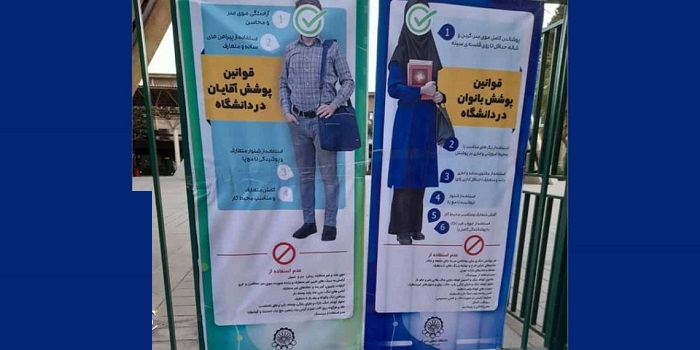

This escalation in regulations is evident across various universities, with a notable increase in surveillance and penalties for non-compliance.
The recent approval of the Hijab and Chastity Bill, which is set for a three-year trial, has heralded an even more restrictive atmosphere in Iranian educational institutions. From Tehran to Isfahan, students are feeling the weight of these new rules.
The Monday of September 25 witnessed an unusual scene at Tehran University. Social media was abuzz with pictures of camouflaged vehicles parading through the university grounds, blaring anthems reminiscent of the Iran-Iraq wartime. These visuals were both perplexing and concerning for many.

Making the regulations clearer and more evident, state-affiliated student councils have put up banners across campuses detailing the new dress code. Additionally, these councils have taken the digital route by sending text messages to students, apprising them of the changed clothing guidelines.
The enforcement of these rules is stringent. At many university entrances, female agents are positioned to inspect the attire of female students. These students are permitted entry only if they don the Maghnaeh, a head covering that extends to cover the shoulders and chest. Additionally, they are required to wear knee-length fatigues.
However, the scrutiny doesn’t end at the gates. Hijab patrols are now a common sight on central campuses, where they continue to monitor and warn students about their attire.
Several universities, including Amir Kabir, Al-Zahra, Allameh Tabatabaii, and Kharazmi in Tehran, as well as Isfahan’s University of Art, have reported similar clothing regulation implementations. The Medical School of Kerman is also in line with this trend, signifying the widespread nature of these regulations.

The University of Shiraz has taken a technological approach to enforcement. Facial recognition technology has been introduced in the university’s eateries to further limit students’ freedoms. The management reportedly spent 700 million Tomans to establish this system. This tech-driven method identifies students who breach the clothing regulations, making it even harder for them to escape notice.
This heightened surveillance and stricter dress code come amidst a broader clampdown on students, with increasing reports of arrests and suspensions. As the academic year progresses, it remains to be seen how students will adapt to or challenge these intensified regulations.

MEK Iran (follow us on Twitter and Facebook), Maryam Rajavi’s on her site, Twitter & Facebook, NCRI (Twitter & Facebook), and People’s Mojahedin Organization of Iran – MEK IRAN – YouTu







